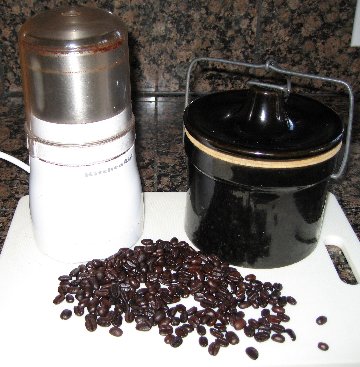Coffee bean’s two greatest enemies are air and moisture. Ideally, coffee should be ground, brewed, and consumed quickly to obtain the best flavor.
Coffee beans are at their peak within 24 to 72 hours after roasting and begin to quickly stale after that (within a week, most of the original flavor will have deteriorated). It is best to buy fresh-roasted coffee beans in quantities that you will use within 7 to 10 days.
Store your coffee in the bags it came in if they are heat sealed film or foil. Once these bags have been opened, you can either transfer the coffee to a clean, dry, air-tight canister, or simply roll the top of the bag closed, forcing out as much air as possible, and seal the bag with a piece of tape or a rubber band.
I, personally recommend grinding your beans as you need them and storing the whole beans in an air-tight canister. With that said, following are some guidelines for storing coffee beans:
Whole Coffee Beans – Should be stored in an air-tight canister in a dry dark, place at room temperature. They will be at their best for about a month after they are roasted (most fine coffees are roasted just before they are sold).
Ground Beans – Ground beans don’s stay fresh as long as whole beans because more surface area is exposed. Keep ground beans in an air-tight canister in a a dry dark, place at room temperature for approximately two weeks.
Vacuum-Pack Coffee – Coffee that is sold in vacuum-packed tins has had oxygen and carbon dioxide removed, a process that keep the coffee fresh. Once the can is opened, the coffee will be in its prime for 7 to 10 days.
Freezing or Refrigerating Coffee Beans – It is generally not recommended to store coffee beans in the freezer or refrigerator. The enemies of coffee are extreme temperatures (hot or cold), air, light, moisture, and strong odors. The freezer is acceptable only for a one-time shot. What this means, is that once you take it out of the freezer, it should never go back in. Condensation can form and adversely affect taste, as the frozen moisture on your coffee will melt and be absorbed into the bean, which deplete the flavorful oils.
More information and interesting coffee articles:
 Coffee – Java Talk – Learn all about the history of coffee, how to taste coffee, and making coffee.
Coffee – Java Talk – Learn all about the history of coffee, how to taste coffee, and making coffee.
Coffee Drink Calories – How much damage can your favorite coffee drink do in additional calories added to your diet? The fancier the drink, the fancier the calories – especially when you opt for the whipped topping. An extra 200 calories a day can add up to 21 extra pounds added to your body per year!
Espresso Machines – Learn about the different Styles for Different Homes.
How To Store Coffee Beans – Coffee bean’s two greatest enemies are air and moisture. Ideally, coffee should be ground, brewed, and consumed quickly to obtain the best flavor.
How to Make the Perfect Cup of Coffee – A great dining experience deserves great coffee!
How To Use a French Press – The most popular coffee maker in Europe and Australia is the classy French Press. Also known as the plunger pot, coffee press, or press-pot. This stylish coffee maker is making in-roads in America, and coffee addicts swear by it.
How To Use A Moka Pot – A Moka Pot is an Italian steam-based stovetop espresso maker that produces a dark coffee almost as strong as that from a conventional espresso maker. Sometimes called the poor man’s espresso and also known as stove-top espresso.
Irish Coffee – It might sound like an ancient recipe, but Irish coffee was a 20th Century invention. Learn the history of this spirited coffee and how it’s made. Also check out the easy-to-make authentic recipe.
Organic Coffee – Organic Coffee for Your Health and the Environment. To gain a better understanding of what the term “Organic Coffee” really means, we have put together this guide to how it relates to your health, and that of our planet!

